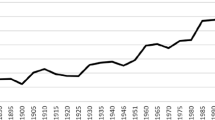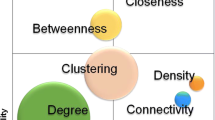Abstract
Recent studies on maritime traffic model the interplay between vessels and ports as a graph, which is often built using automatic identification system (AIS) data. However, only a few works explicitly study the evolution of such graphs and, when they do, generally consider coarse-grained time intervals. Our goal is to fill this gap by providing a conceptual framework for the fine-grained systematic study of maritime graphs evolution. To this end, this paper presents the month-by-month analysis of world-wide graphs built using a 3-years AIS dataset. The analysis focuses on the evolution of several topological graph features, as well as their stationarity and statistical correlation. Results have revealed some interesting seasonal and trending patterns that can provide insights in the world-wide maritime context and be used as building blocks toward the prediction of graphs topology.















Similar content being viewed by others
References
Zar JH (2008) Spearman Rank Correlation Coefficient. Springer, New York, pp 502–505. https://doi.org/10.1007/978-0-387-32833-1_379
Bartholdi JJ, Jarumaneeroj P, Ramudhin A (2016) A new connectivity index for container ports. Maritime Econ Logist 18(3):231–249
Blake GH (2004) Maritime boundaries. In: The oceans: Key issues in marine affairs. Springer, pp 63–76
Brockwell PJ, Davis RA (2016) Introduction to time series and forecasting. Springer, Berlin
Carlini E, de Lira VM, Soares A, Etemad M, Machado BB, Matwin S (2020) Uncovering vessel movement patterns from ais data with graph evolution analysis. In: EDBT/ICDT Workshops
Cavaliere G, Robert Taylor A (2008) Time-transformed unit root tests for models with non-stationary volatility. J Time Ser Anal 29(2):300–330
Chatfield C (2000) Time-series forecasting. Chapman and hall/CRC, Boca Raton
Cheung YW, Lai KS (1995) Lag order and critical values of the augmented dickey–fuller test. J Business Econ Stat 13(3):277–280
Cleveland RB, Cleveland WS, McRae JE, Terpenning I (1990) Stl: a seasonal-trend decomposition. J Official Stat 6(1):3–73
Coscia P, Braca P, Millefiori LM, Palmieri FAN, Willett P (2018) Multiple Ornstein–Uhlenbeck Processes for Maritime Traffic Graph Representation. IEEE Trans Aerospace Electron Syst 54(5):2158–2170. https://doi.org/10.1109/TAES.2018.2808098. https://ieeexplore.ieee.org/document/8295117/
Dickey DA, Fuller WA (1979) Distribution of the estimators for autoregressive time series with a unit root. J Amer Stat Assoc 74(366a):427–431
Ducruet C (2017) Multilayer dynamics of complex spatial networks: The case of global maritime flows (1977–2008). J Transp Geogr 60:47–58
Edition SC (2004) Safety of life at sea (solas), consolidated edition. IMO, London
Etemad M, Júnior A. S., Matwin S (2018) Predicting transportation modes of gps trajectories using feature engineering and noise removal. In: Canadian conference on artificial intelligence. Springer, pp 259–264
Ford JH (2020) ExactEarth. https://www.exactearth.com/. last accessed: September 2021
Fagiolo G, Mastrorillo M (2013) International migration network: Topology and modeling. Phys Rev E 88(1):012,812
Filipiak D, We K, Abramowicz W (2020) Extracting maritime traffic networks from AIS data using evolutionary algorithm. Bus Inf Syst Eng 17
Franses PH (1991) Seasonality, non-stationarity and the forecasting of monthly time series. Int J Forecast 7(2):199–208
Ghanavati G, Hines PD, Lakoba TI, Cotilla-Sanchez E (2014) Understanding early indicators of critical transitions in power systems from autocorrelation functions. IEEE Trans Circ Syst I: Regular Papers 61(9):2747–2760
Gollasch S, Hewitt CL, Bailey S, David M (2019) Introductions and transfers of species by ballast water in the adriatic sea. Marine Poll Bull 147:8–15. https://doi.org/10.1016/j.marpolbul.2018.08.054. http://www.sciencedirect.com/science/article/pii/S0025326X1830626X
Hernández JM, Van Mieghem P (2011) Classification of graph metrics. Delft University of Technology, The Netherlands, pp 1–20
Kaluza P, Kölzsch A, Gastner MT, Blasius B (2010) The complex network of global cargo ship movements. J R Soc Interface 7(48):1093–1103
Kirch W. (ed) (2008) Pearson’s Correlation Coefficient. Springer, Netherlands. https://doi.org/10.1007/978-1-4020-5614-7_2569
Kitagawa G, Akaike H (1978) A procedure for the modeling of non-stationary time series. Ann Inst Stat Math 30(2):351–363
Kosowska-Stamirowska Z, Ducruet C, Rai N (2016) Evolving structure of the maritime trade network: evidence from the lloyd’s shipping index (1890–2000). J Shipp Trade 1(1):10
Laxe FG, Seoane MJF, Montes CP (2012) Maritime degree, centrality and vulnerability: port hierarchies and emerging areas in containerized transport (2008–2010). J Transp Geogr 24:33–44
McCabe BP, Tremayne AR (1995) Testing a time series for difference stationarity. The Annals Stat 1015–1028
Montes CP, Seoane MJF, Laxe FG (2012) General cargo and containership emergent routes: a complex networks description. Transp Policy 24:126–140
Pham KH, Miguel L-O (2020) World Port Index. https://msi.nga.mil/Publications/WPI. last accessed: September 2021
Perera LP, Oliveira P, Soares CG (2012) Maritime traffic monitoring based on vessel detection, tracking, state estimation, and trajectory prediction. IEEE Trans Intell Transp Syst 13(3):1188–1200
Santipantakis GM, Glenis A, Patroumpas K., Vlachou A, Doulkeridis C, Vouros GA, Pelekis N, Theodoridis Y (2020) SPARTAN: Semantic integration of big spatio-temporal data from streaming and archival sources. Future Gener Comput Syst 110:540–555. https://doi.org/10.1016/j.future.2018.07.007. https://linkinghub.elsevier.com/retrieve/pii/S0167739X17320319
Soares A, Dividino R, Abreu F, Brousseau M, Isenor AW, Webb S, Matwin S (2019) Crisis: Integrating ais and ocean data streams using semantic web standards for event detection. In: 2019 International conference on military communications and information systems (ICMCIS). IEEE, pp 1–7
Varlamis I, Kontopoulos I, Tserpes K, Etemad M, Soares A, Matwin S (2020) Building navigation networks from multi-vessel trajectory data. GeoInformatica 1–29
Varlamis I, Tserpes K, Etemad M, Júnior AS, Matwin S (2019) A network abstraction of multi-vessel trajectory data for detecting anomalies. In: Proceedings of the Workshops of the EDBT/ICDT 2019 Joint Conference
Vespe M, Greidanus H, Alvarez MA (2015) The declining impact of piracy on maritime transport in the indian ocean: Statistical analysis of 5-year vessel tracking data. Mar Policy 59:9–15
Vespe M, Visentini I, Bryan K, Braca P (2012) Unsupervised learning of maritime traffic patterns for anomaly detection. In: 9Th IET data fusion target tracking conference (DF TT 2012): Algorithms applications, pp 1–5
Wang Z, Claramunt C, Wang Y (2019) Extracting global shipping networks from massive historical automatic identification system sensor data: a bottom-up approach. Sensors 19(15):3363
Yan Z, Xiao Y, Cheng L, He R, Ruan X, Zhou X, Li M, Bin R (2020) Exploring ais data for intelligent maritime routes extraction. Appl Ocean Res 101(102):271
Zhang SK, Shi GY, Liu ZJ, Zhao ZW, Wu ZL (2018) Data-driven based automatic maritime routing from massive ais trajectories in the face of disparity. Ocean Eng 155:240–250
Zissis D, Chatzikokolakis K, Spiliopoulos G, Vodas M (2020) A distributed spatial method for modeling maritime routes. IEEE Access 8:47,556–47,568. https://doi.org/10.1109/ACCESS.2020.2979612. https://ieeexplore.ieee.org/document/9028151/
Acknowledgment
The authors acknowledge the support of the H2020 EU Project MASTER (Multiple ASpects TrajEctoRy management and analysis) funded under the Marie Skłodowska-Curie grant agreement No 777695.
Author information
Authors and Affiliations
Corresponding author
Additional information
Publisher’s note
Springer Nature remains neutral with regard to jurisdictional claims in published maps and institutional affiliations.
Rights and permissions
About this article
Cite this article
Carlini, E., de Lira, V., Soares, A. et al. Understanding evolution of maritime networks from automatic identification system data. Geoinformatica 26, 479–503 (2022). https://doi.org/10.1007/s10707-021-00451-0
Received:
Revised:
Accepted:
Published:
Issue Date:
DOI: https://doi.org/10.1007/s10707-021-00451-0




